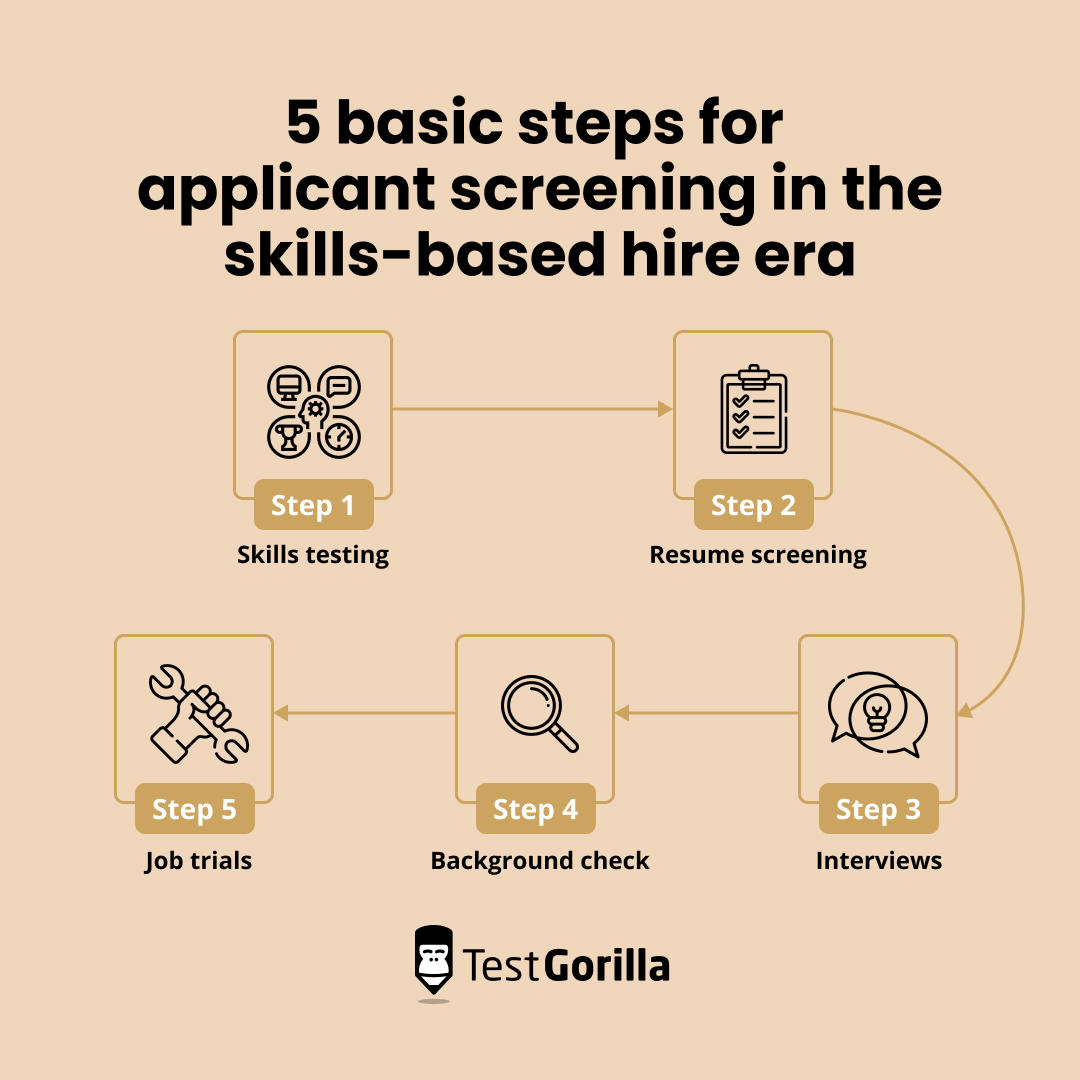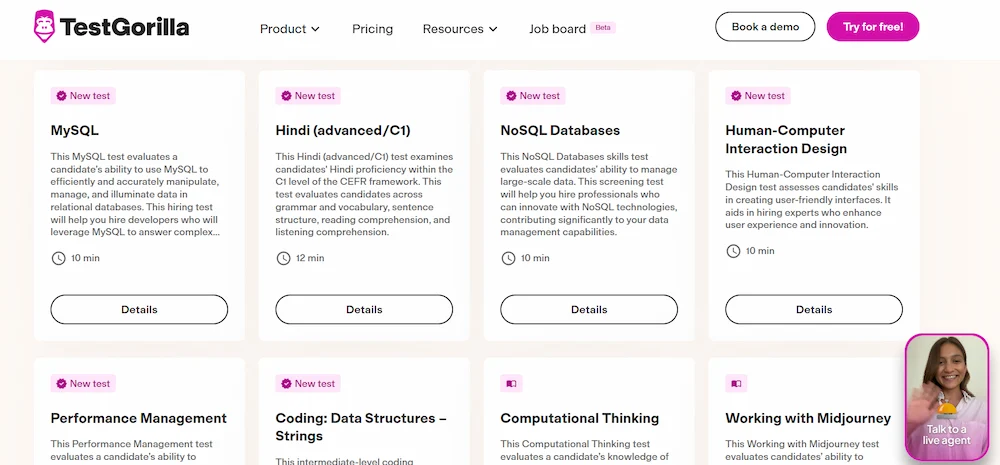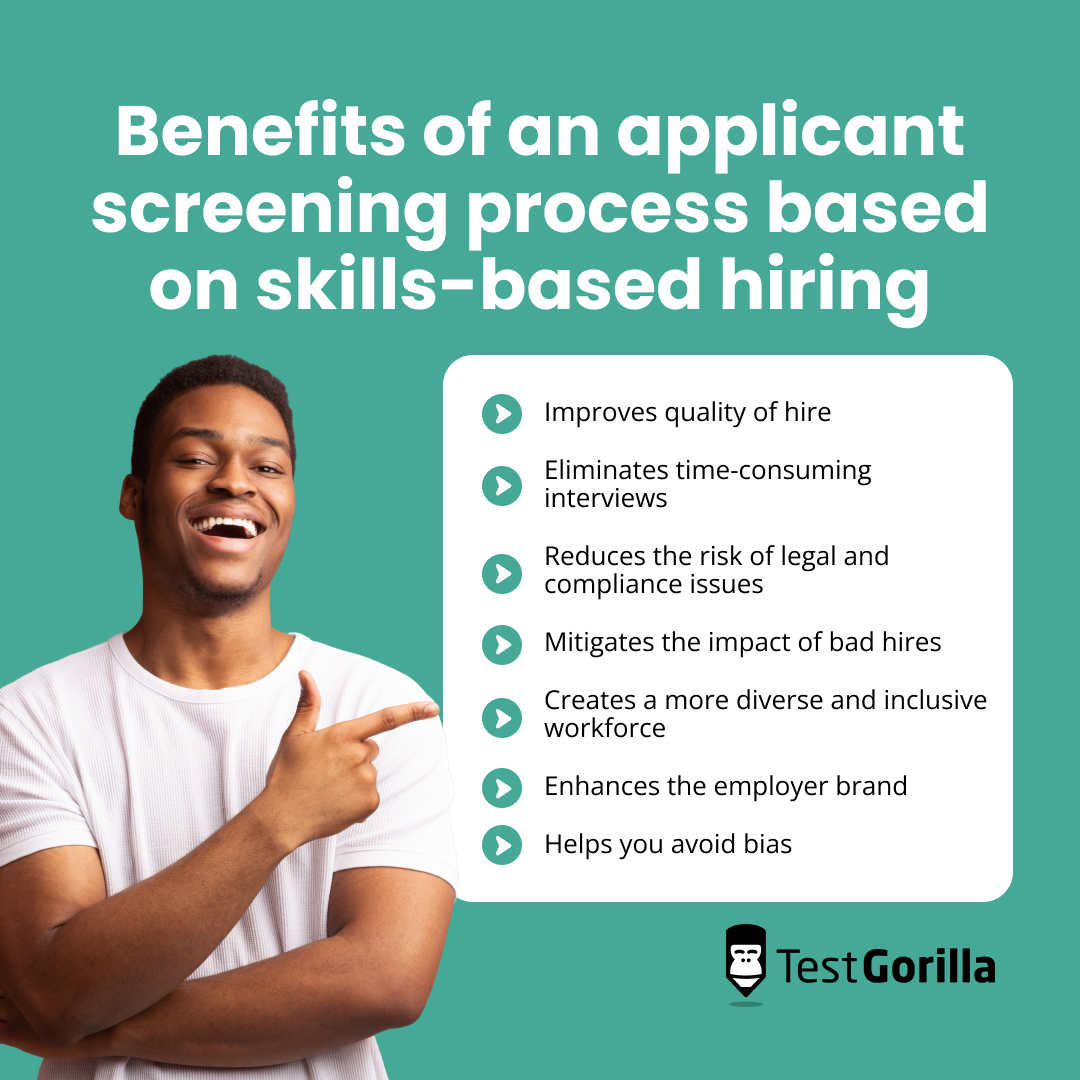Applications are pouring in after crafting and sharing your job description.
Now, your next hurdle is the applicant screening process.
This intricate process, if not executed effectively, can lead to a time-consuming maze of unqualified jobseekers.
This guide will provide you with ideas and insights to effectively identify and shortlist the best applicants. You'll learn about the most important steps for an effective screening process plus what to ask applicants during screening.
But first things first.
What is applicant screening?
Applicant screening is part of the talent acquisition process. At this stage, hiring teams evaluate applicants to determine which of them might be a good fit for a job opening.
There are many different factors you need to consider when it comes to screening applicants, including:
Their qualifications
Whether they are a good cultural fit, and
If they have the required skills for the job
Traditionally, applicant screening required reading through potentially hundreds of resumes to find people who might be a good fit. But with the latest technology, there are more efficient alternatives (which you will learn more about below).
Steps in the applicant screening process
The applicant screening process involves a series of steps designed to evaluate an applicant's qualifications, skills, and suitability for the role.
The traditional way of applicant screening looks like this:
Step 1: Resume screening
Step 2: Phone screening interview
Step 3: On-site interviews
Step 4: Background check
Step 5: Job trials
However, in an era of skills-based hiring, applicant screening has the following basic steps:
Step 1: Skills testing
Step 2: Resume screening
Step 3: Interviews
Step 4: Background check
Step 5: Job trials
As you can see with the comparison above, applicant screening through the lens of a skills-based hiring approach is more efficient (e.g. interviews aren't done twice). Let's take a closer look at each step below.
Step 1: Skills testing
Conducting pre-employment testing before resume screening can be a more holistic approach to applicant screening by providing a more objective and unbiased evaluation of an individual's skills and abilities.
Instead of relying solely on resumes and cover letters, which can be subjective and biased, skills testing provides a standardized and objective way to assess applicants' technical and practical skills.
This can be especially beneficial for roles that require specific skills or knowledge, such as software development, data analysis, or design.
Here are some of the benefits of skills testing as a first step in applicant screening process:
Identify skills gaps early on
When you conduct skills testing upfront, you can quickly identify applicants who lack the necessary skills for the role, saving time and resources that would otherwise be spent on interviewing and evaluating unqualified applicants.
Spot high-potential individuals
Skills testing can help identify individuals who may not have the traditional qualifications or experience listed on their resumes but possess the underlying skills and potential to succeed in the role.
Maria Villegas, SEO specialist at TestGorilla, is a good example. Before doing SEO work, Maria studied medicine for six years. She did unpaid work for family and friends to gain SEO experience. TestGorilla, acknowledging this gap, allowed María to showcase her skills through assessments, bypassing the traditional resume process.
The result: María found a great job, and our organization gained a valuable hire. Explore similar success stories on skills-based hiring.
More focused and relevant interviews later in the process
By better understanding an applicant's skills and abilities through skills testing, you can conduct more focused and relevant interviews. For example, you can ask more specific questions and assess an applicant's fit for the specific role.
Assess for culture add early in the hiring process
What exactly is culture add?
At TestGorilla, we believe in prioritizing culture add over culture fit, meaning adding someone to your culture rather than fitting someone into it.
Hiring someone you think will “fit in” is problematic. Recruiters sometimes mistake organizational culture or values with whether an applicant would be willing to socialize with team members outside of work. This type of thinking reinforces existing biases and narrows a person’s ability to perform a job to their shared hobbies or interests with their colleagues.
Learn more: Culture add vs. culture fit
Reduces time to hire
Did you know that the average time to hire is 42 days? Or that applicant screening is one of the factors that can increase your time to fill? The best way to reduce your time to fill is to use skills testing.
When you use a skills test near the start of your applicant screening approach, you’re choosing to reduce your time to fill as skills testing helps you filter those applicants who look good on paper but lack the skills for the job. It also means you spend less time screening resumes or interviewing those applicants who are simply expert interviewees (but not really skilled in the first place).
Helps you avoid bias
While HR professionals may try to stay entirely objective when screening applicants, unconscious bias can always creep in and influence your decision-making. But with skills tests, you can quantify applicants' skills and make decisions based on the numbers.
America’s largest companies, including Google and Apple, have implemented skills testing in their recruitment process to ensure their selection is bias-free. It’s beneficial for you and your applicants, letting you base your screening decision on objective results as opposed to your intuition.
You can incorporate skills-based testing early in your hiring process with the following best practices:
Identify the most crucial skill sets required for the job. These skills are essential to the role and should be tested at the beginning of your applicant screening process. For instance, if using Svelte is a core skill, consider testing all applicants using a Svelte test before reviewing their resumes.
Choose a relevant assessment. You can either build your own or select from a library of pre-built tests such as role-specific tests and behavioral assessments. Additionally, you can mix and match tests from different categories, such as problem-solving, language proficiency, soft skills, and personality tests.
Create an automated process. If the first step of your applicant process is to screen applicants based on a test, use your applicant tracking system (ATS) to trigger an automated email to the hiring manager. This email should include the test results of the best-scoring applicants. This way, you can quickly identify the top applicants and move them to the next stage.
Step 2: Resume screening
Once qualified applicants have passed your initial skills assessment, you can review their resumes to better understand their experience, education, and accomplishments.
When combined together, skills testing and resume review provide valuable insights and a more comprehensive picture of each applicant's qualifications.
Recommended reading: Resume screening made simple (A guide for recruiters)
Step 3: Interviews
Once aspirants have passed the initial skills assessment and their resumes have been reviewed, the interview process is the next step when screening applicants.
At this point, you can delve deeper into the applicants' qualifications, experience, and cultural fit to identify the best person for the role.
There are several different types of interviews that you can use, depending on the role and the company's culture. Some common types of interviews you can do are:
Phone screen: This brief phone interview is to get to know applicants better and assess their general qualifications.
Video interview: This is a more formal interview conducted over video chat. Video interviews allow you to see applicants' body language and facial expressions, which can provide additional insights into their personality and communication skills. If you’re pressed for time, one-way video interviews are also worth exploring.
Panel interview: This is an interview with multiple people from the company, such as the hiring manager, team members, and representatives from HR. Panel interviews allow applicants to get a feel for the company culture and meet the people they would be working with.
Sample applicant screening questions
Use these questions to assess specific skills relevant to the job and allow applicants to showcase their practical abilities through real-world examples.
For technical roles: Can you walk us through a specific project where you applied your coding/programming skills? What challenges did you face, and how did you overcome them?
Problem-solving skills: Describe a complex problem you encountered in your previous role. How did you approach it, and what was the result?
Analytical skills: How do you typically analyze data or information to make informed decisions? Can you provide an example from your work experience?
Communication skills: Can you share an instance where you effectively communicated a complex idea or concept to a non-technical audience?
Creativity and innovation: Describe a situation where you introduced a new idea or process that positively impacted your team or project.
Attention to detail: How do you ensure accuracy and attention to detail in your work? Can you give an example of a time when this was crucial?
Time management: How do you prioritize tasks and manage your time effectively, especially when faced with tight deadlines or multiple projects?
Customer service skills: Provide an example of a challenging customer interaction you've had. How did you handle it, and what was the outcome?
Adaptability: Describe a situation where you had to learn and apply a new skill or technology quickly. How did you approach the learning process?
Collaboration and teamwork: Share an experience where you worked closely with a diverse team to achieve a common goal. How did you contribute to the team's success?
Step 4: Background check
You're more than halfway through the applicant screening process! The next step is to perform comprehensive background checks.
Background checks are crucial in ensuring the accuracy of the information provided by applicants and verifying their suitability for the open position.
This step aims to gather information about an applicant's past employment history, educational background, criminal records, and, in some cases, credit history. Use the following guides we've written about background checks to help you get started:
Step 5: Job trials
A job trial helps you and the rest of the recruiting team evaluate an applicant's skills and abilities in a real-world setting before making a final hiring decision.
Job trials typically involve a structured approach like the one below:
Defined tasks and responsibilities
Clear criteria for assessing applicants' performance (e.g. their ability to complete tasks effectively, collaborate with others, and problem-solving skills)
Constructive feedback throughout the trial period
When implementing job trials in the applicant selection process, pay attention to the following:
Fair compensation for their time and effort during the trial period, demonstrating respect for their participation.
Be clear in communicating the goals and expectations of the trial period to ensure applicants understand the assessment process.
Provide constructive feedback and guidance throughout the trial.
Maintain transparency and fairness throughout the trial process to ensure that all applicants are evaluated equally and objectively.
The best insights on HR and recruitment, delivered to your inbox.
Biweekly updates. No spam. Unsubscribe any time.
Benefits of an applicant screening process based on skills-based hiring
Now that you already know the steps in a typical applicant screening process, it's time to put it into action.
The following are the benefits of the applicant screening process with a skills-based hiring approach:
1. Improves quality of hire
When your organization carefully evaluates an applicant's qualifications, skills, and cultural fit, you are more likely to make informed hiring decisions and find the most qualified candidates. Higher quality of hire translates to increased productivity, improved employee morale, and reduced turnover.
2. Eliminates time-consuming interviews
A well-structured screening process can streamline your hiring process, eliminating time-consuming interviews with unqualified applicants. This lets you focus on the most promising aspirants, saving valuable time and resources.
3. Reduces the risk of legal and compliance issues
Thorough background checks and reference checks can help identify potential legal or compliance issues with applicants before they are hired. This can protect your organization from legal liability and reputational damage.
4. Mitigates the impact of bad hires
Bad hires can be costly in terms of lost productivity, damaged morale, and legal issues. A thorough screening process can help prevent bad hires, saving your organization money and protecting its reputation.
5. Creates a more diverse and inclusive workforce
With unbiased screening practices and a diverse pool of applicants, you're on your way to creating a more diverse and inclusive workforce. This can lead to increased creativity, innovation, and problem-solving capabilities.
6. Enhances employer brand
Applicants who experience a fair and transparent screening process are more likely to have a positive impression of your organization. This makes for a positive employer brand.
7. Helps you avoid bias
Though all HR professionals try to stay entirely objective when screening applicants, unconscious bias can always creep in and influence your decision-making. But with skills tests, you can quantify your applicants’ skills and make decisions based on the numbers.
How to use AI during applicant screening
With AI (artificial intelligence) evolving rapidly, here are several ways to use AI for a more effective screening process.
1. Automated resume screening
AI-powered tools can scan resumes and extract relevant information, such as skills, experience, and education, to identify applicants with the basic qualifications for a position.
2. Chatbots for initial interaction
Use AI-driven chatbots to engage with applicants during the initial stages of the application process. Chatbots can also answer basic questions, provide information about the company and the application process, and even conduct preliminary assessments.
3. Skills testing
AI can develop and administer skills tests that assess an applicant's technical abilities, knowledge, and problem-solving skills. These tests can be more objective and efficient than traditional methods, such as interviews, and can help employers identify suitable appplicants.
4. Automated interview scheduling
Use AI-powered tools to streamline the interview scheduling process based on the availability of both applicants and interviewers. This reduces administrative burdens and enhances the overall candidate experience.
Recommending reading: AI in talent acquisition (How to leverage this trend ethically and efficiently)
Shake up your applicant screening process with skills testing
Applicant screening can be tricky, particularly if you're flooded with resumes due to high volume hiring. But don't lose your cool. With skills-based testing and the rest of the steps outlined above, screening applicants shouldn't be a chore for you and your team of recruiters.
See how easy it can be by checking out our test library or requesting a 30-minute live product demo.
Want to go straight into action? Sign up for a free trial of TestGorilla.
You've scrolled this far
Why not try TestGorilla for free, and see what happens when you put skills first.


















